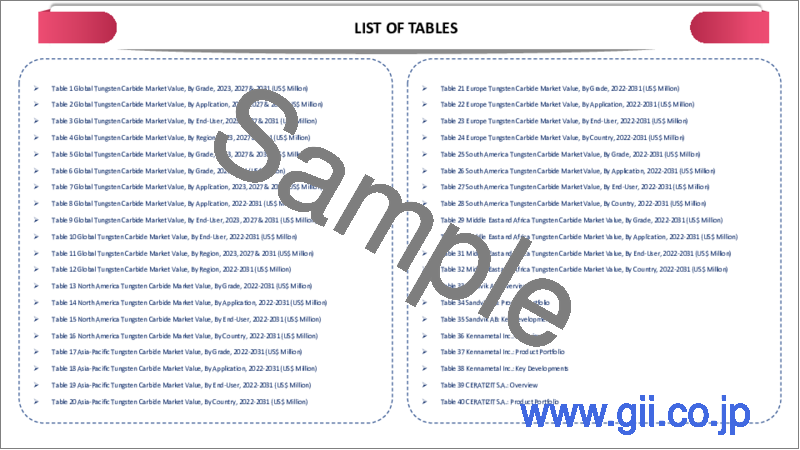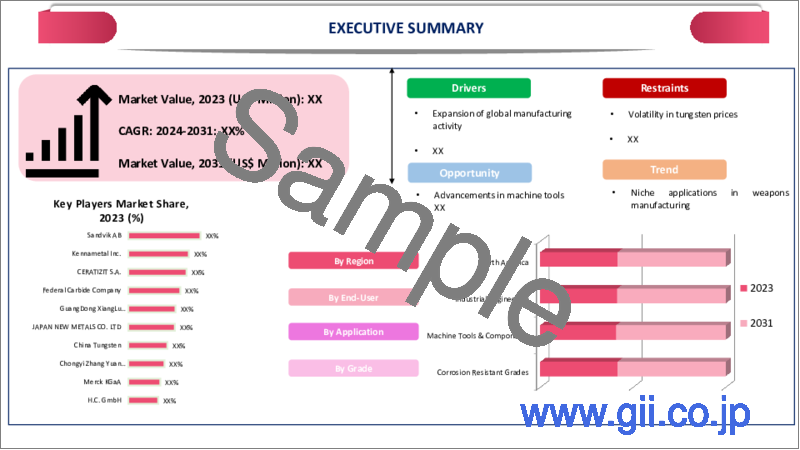|
|
市場調査レポート
商品コード
1304525
炭化タングステンの世界市場-2023年~2030年Global Tungsten Carbide Market - 2023-2030 |
||||||
カスタマイズ可能
適宜更新あり
|
|||||||
| 炭化タングステンの世界市場-2023年~2030年 |
|
出版日: 2023年07月07日
発行: DataM Intelligence
ページ情報: 英文 205 Pages
納期: 即日から翌営業日
|
- 全表示
- 概要
- 目次
市場概要
炭化タングステンの世界市場は、2022年に202億米ドルに達し、2023年から2030年の予測期間中に7.0%のCAGRで成長し、2030年までに347億米ドルに達すると予測されています。
炭化タングステンの世界市場は、製造業からの需要が大幅に増加する予定です。中国における製造業の力強い拡大、インドにおける新たな製造プロジェクトの立ち上げ、ハイテク製造業を誘致する米国の取り組みは、超硬工具の需要を増加させる主な要因となっています。
主要な炭化タングステンメーカーは、おそらく地元の需要の増加に応えるために、発展途上国で製造事業を拡大します。例えば、2022年12月、多国籍冶金企業であるUnited Wolframは、インドのグジャラート州に新しいタングステン製造工場を開設しました。
市場力学
世界な製造活動の拡大
COVID-19の大流行後、製造業は力強い成長を遂げました。例えば、中国の製造業PMIは2023年1月の50.1から2023年2月には52.6に上昇し、2012年以来最も速い伸びを記録しました。インドの製造業PMIは2023年5月に58.7と過去最高を記録しました。
製造業セクターの拡大は、超硬製工作機械と部品の新たな需要を生み出すと思われます。炭化タングステンは、製造工程における材料の機械加工、切断、穴あけ、成形に不可欠です。産業が拡大し、生産能力が高まるにつれて、超硬工具の需要は大幅に増加すると予想されます。
新興諸国におけるインフラ整備の拡大
新興諸国は、国民の生活水準を引き上げ、経済成長を促進するため、インフラ整備に多額の投資を行っています。現在、インフラ開発の大半はアジア太平洋諸国で行われています。アジア開発銀行(ADB)の推計によると、アジア太平洋地域は年間8,810億米ドルをインフラ整備に費やしています。さらに同行は、経済成長の勢いを維持するためには、年間1兆7,000億米ドルまで支出を増やす必要があると見積もっています。
炭化タングステンはその硬度から、電気ノコギリや掘削装置のドリルビットに広く使用されています。現在進行中の港湾、空港、高速道路、橋梁、高速鉄道、都市大量輸送システムの建設は、短中期的に炭化タングステンの需要を大幅に増加させると予想されます。
タングステン価格の変動
炭化タングステンは主原料として金属タングステンに依存しています。タングステンは比較的希少な資源であり、その価格は、需給関係、地政学的緊張、マクロ経済情勢など様々な要因によって変動します。タングステン価格は、2023年1月から5月にかけてMTU(メートル・トン・ユニット)当たり320~350米ドル以内と、比較的高い水準で推移しています。
タングステンの価格変動は、炭化タングステンの製造・生産工程に大きな影響を与えます。タングステンの価格が上昇すると、メーカーは原材料の調達コストが上昇し、収益性が悪化する可能性があります。タングステン価格の変動は、このように需要が減少し、世界の炭化タングステン市場の成長を抑制し、新しいプロジェクトへの資本支出を妨げる可能性があります。
COVID-19影響分析
COVID-19パンデミックは世界のサプライチェーンを混乱させ、経済の不確実性を引き起こし、炭化タングステン市場を含む様々な産業に影響を与えました。世界各国の政府による移動や製造の制限が産業活動の衰退を招き、炭化タングステン製品の需要が減少しました。
加えて、炭化タングステンの重要なエンドユーザーである鉱業や製造業の減速は、さらに市場の成長に影響を与えました。しかし、パンデミックの余波で世界経済が回復し、産業が成長の勢いを取り戻すにつれて、炭化タングステンの需要は回復し、今後数年間は堅調に推移すると予想されます。
ウクライナ・ロシア戦争の影響
ロシアは2022年に約2300トンを生産するタングステンの世界の主要生産国であるため、ウクライナ・ロシア戦争はタングステンの供給を混乱させ、国際市場に短期的な価格変動をもたらしました。ロシアが残した穴は、中国など他の主要タングステン生産国が埋めることになると予想されます。
主にロシアによる天然ガス供給の中断が原因で、欧州ではエネルギー価格が大幅に上昇しました。これにより、欧州の炭化タングステンメーカーの競争力は劇的に低下しました。アジアのメーカーにとっては、大きな市場シェアを獲得する大きなチャンスとなっています。
目次
第1章 調査手法と調査範囲
第2章 定義と概要
第3章 エグゼクティブサマリー
第4章 市場力学
- 影響要因
- 促進要因
- 鉱業活動の拡大
- 製造プロセスの進歩
- 世界な製造活動の拡大
- 新興経済諸国におけるインフラ整備の進展
- 抑制要因
- タングステン価格の変動
- より優れた代替品の入手可能性
- 機会
- 影響分析
- 促進要因
第5章 産業分析
- ポーターのファイブフォース分析
- サプライチェーン分析
- 価格分析
- 規制分析
第6章 COVID-19分析
第7章 グレード別
- 回転掘削および採鉱用グレード
- サブミクロングレード
- 金属成形および摩耗グレード
- 耐食性グレード
- 汎用グレード
- その他
第8章 用途別
- 工作機械・部品
- 金型・パンチ
- 切削工具
- 研磨製品
- その他
第9章 エンドユーザー別
- 鉱業・建設
- 運輸
- インダストリアルエンジニアリング
- 石油・ガス
- 航空宇宙・防衛
- その他
第10章 地域別
- 北米
- 米国
- カナダ
- メキシコ
- 欧州
- ドイツ
- 英国
- フランス
- イタリア
- スペイン
- その他欧州
- 南米
- ブラジル
- アルゼンチン
- その他南米
- アジア太平洋
- 中国
- インド
- 日本
- オーストラリア
- その他アジア太平洋地域
- 中東・アフリカ
第11章 競合情勢
- 競合シナリオ
- 市況/シェア分析
- M&A分析
第12章 企業プロファイル
- Sandvik AB
- 会社概要
- グレード・ポートフォリオと概要
- 財務概要
- 最近の動向
- Kennametal Inc.
- CERATIZIT S.A.
- Federal Carbide Company
- GuangDong XiangLu Tungsten Co. Ltd.
- JAPAN NEW METALS CO. LTD
- China Tungsten
- Chongyi Zhang Yuan Tungsten Co. Ltd
- Merck KGaA
- H.C. GmbH
第13章 付録
Market Overview
The Global Tungsten Carbide Market reached US$ 20.2 billion in 2022 and is expected to reach US$ 34.7 billion by 2030, growing with a CAGR of 7.0% during the forecast period 2023-2030.
The Global Tungsten Carbide Market is slated to witness a significant increase in demand from the manufacturing industry. Strong expansion of the manufacturing sector in China, the setting up of new manufacturing projects in India and the U.S. efforts to attract more high-tech manufacturing are major factors in increasing demand for tungsten carbide tools.
Major tungsten carbide manufacturers will likely expand their manufacturing operations in developing countries to cater to the growing local demand. For instance, in December 2022, United Wolfram, a multinational metallurgy company, opened a new Tungsten manufacturing plant in Gujarat, India.
Market Dynamics
Expansion of Global Manufacturing Activities
The manufacturing sector has witnessed strong growth after the COVID-19 pandemic. For instance, China's manufacturing PMI grew to 52.6 in February 2023 from 50.1 in January 2023, registering the fastest expansion since 2012. India's manufacturing PMI increased to an all-time high of 58.7 in May 2023.
The expansion of the manufacturing sector will create renewed demand for tungsten carbide machine tools and components. Tungsten carbide is essential for machining, cutting, drilling, and shaping materials in manufacturing processes. As industries expand and production capacities increase, the demand for tungsten carbide tools is expected to rise significantly.
Growing Infrastructure Development in Emerging Countries
Emerging countries are heavily investing in infrastructure development to raise living standards for their population and drive economic growth. A majority of the infrastructure development currently occurs in countries in Asia-Pacific. The Asian Development Bank (ADB) estimates that Asia-Pacific spends US$ 881 billion on infrastructure annually. The bank further estimates that spending needs to increase to US$ 1.7 trillion annually to maintain economic growth momentum.
Due to its hardness, tungsten carbide is widely used in electric saw and drill bits for drilling equipment. The ongoing construction of new ports, airports, expressways, bridges, high-speed rail and urban mass transit systems is expected to significantly increase the demand for tungsten carbide in the short and medium term.
Volatility in Tungsten Prices
Tungsten carbide relies on tungsten metal as a primary raw material. Tungsten is a relatively scarce resource, and its price is subject to fluctuations due to various factors such as supply-demand dynamics, geopolitical tensions, and macroeconomic conditions. Tungsten prices remain relatively high, within US$ 320-350 per MTU (metric ton units) from January to May 2023.
The price volatility of tungsten can significantly impact the manufacturing and production processes of tungsten carbide. When tungsten prices rise, manufacturers may face higher costs for acquiring raw materials, which can strain their profitability. Volatility in tungsten prices can prevent capital expenditure on new projects, thus reducing demand and restraining the growth of the Global Tungsten Carbide Market.
COVID-19 Impact Analysis
The COVID-19 pandemic disrupted global supply chains and caused economic uncertainty, affecting various industries, including the tungsten carbide market. The restrictions on movement and manufacturing imposed by governments worldwide led to a decline in industrial activities and reduced demand for tungsten carbide products.
Additionally, the slowdown in mining and manufacturing sectors, which are significant end-users of tungsten carbide, further impacted market growth. However, as the global economy recovered in the aftermath of the pandemic and industries regained growth momentum, the demand for tungsten carbide has rebounded and is expected to remain strong over the coming years.
Ukraine-Russia War Impact
Since Russia is a major global producer of tungsten, producing nearly 2300 metric tons in 2022, the Ukraine-Russia war has disrupted tungsten supplies and created short-term price volatility in the international markets. It is expected that other major tungsten producers, such as China, will fill the gap Russia left.
Energy prices have increased significantly in Europe, mainly due to Russia's disruption of natural gas supplies. It has dramatically reduced the competitiveness of European tungsten carbide manufacturers. It presents a significant opportunity to Asian manufacturers to capture a large market share.
Segment Analysis
The Global Tungsten Carbide Market is segmented based on grade, application, end-user and region.
Rising Energy Demand will Boost the Growth of the Oil and Gas Industry
Oil and gas accounts for a quarter of the market share of the global tungsten carbide market. Multinational energy companies exploit offshore oil and gas reserves to offset stagnating production in existing fields and cater to rising energy demand as industrialization kicks off in developing countries.
Tungsten carbide is extensively used in drilling and exploration activities in the oil and gas sector. Tungsten carbide drill bits and cutting tools exhibit exceptional hardness, wear resistance, and heat resistance, making them suitable for challenging drilling conditions. The oil and gas industry operates in harsh environments involving abrasive substances, high temperatures, and corrosive fluids. Tungsten carbide is utilized in wear-resistant components such as valve balls, seats, seals, nozzles, and bearings.
Geographical Analysis
Reshoring of the Manufacturing Industry is Likely to Augment Market Growth in North America
Amid rising geopolitical tensions, North American countries, especially U.S., is attempting to recoup their competitive edge in manufacturing and moving high-tech manufacturing back to North America. The U.S. government has rolled out various subsidies and incentives to return American and multinational companies to the region.
The U.S. Congress has passed the Inflation Reduction Act (IRA) and the CHIPS Act, which allocated billions in new subsidies for various manufacturing sectors. Since the passage of the acts in late 2022, companies have committed more than US$ 200 billion in new manufacturing projects, more than double that of 2021 and 2022. In January 2023, Samsung announced that its new US$ 17 billion semiconductor fab in Texas, U.S., will commence operations by the end of 2023.
The proliferation of new manufacturing projects will significantly boost demand for various types of tungsten carbide machine tools and other components.
Competitive Landscape
The major global players include: Sandvik AB, Kennametal Inc., CERATIZIT S.A., Federal Carbide Company, GuangDong XiangLu Tungsten Co. Ltd., JAPAN NEW METALS CO. LTD, China Tungsten, Chongyi Zhang Yuan Tungsten Co. Ltd, Merck KGaA and H.C. GmbH.
Why Purchase the Report?
- To visualize the Global Tungsten Carbide Market segmentation based on grade, application, end-user and region, and understand key commercial assets and players.
- Identify commercial opportunities by analyzing trends and co-development.
- Excel data sheet with numerous tungsten carbide market-level data points with all segments.
- PDF report consists of a comprehensive analysis after exhaustive qualitative interviews and an in-depth study.
- Product mapping available as Excel consisting of key products of all the major players.
The Global Tungsten Carbide Market Report Would Provide Approximately 57 Tables, 66 Figures And 205 pages.
Target Audience 2023
- Manufacturers/ Buyers
- Industry Investors/Investment Bankers
- Research Professionals
- Emerging Companies
Table of Contents
1. Methodology and Scope
- 1.1. Research Methodology
- 1.2. Research Objective and Scope of the Report
2. Definition and Overview
3. Executive Summary
- 3.1. Snippet by Grade
- 3.2. Snippet by Application
- 3.3. Snippet by End-User
- 3.4. Snippet by Region
4. Dynamics
- 4.1. Impacting Factors
- 4.1.1. Drivers
- 4.1.1.1. Expansion of Mining Activities
- 4.1.1.2. Advancements in Manufacturing Processes
- 4.1.1.3. Expansion of Global Manufacturing Activities
- 4.1.1.4. Growing Infrastructure Development in Emerging Economies
- 4.1.2. Restraints
- 4.1.2.1. Volatility in Tungsten Prices
- 4.1.2.2. Availability of Better Alternatives
- 4.1.3. Opportunity
- 4.1.4. Impact Analysis
- 4.1.1. Drivers
5. Industry Analysis
- 5.1. Porter's Five Force Analysis
- 5.2. Supply Chain Analysis
- 5.3. Pricing Analysis
- 5.4. Regulatory Analysis
6. COVID-19 Analysis
- 6.1. Analysis of COVID-19
- 6.1.1. Scenario Before COVID
- 6.1.2. Scenario During COVID
- 6.1.3. Scenario Post COVID
- 6.2. Pricing Dynamics Amid COVID-19
- 6.3. Demand-Supply Spectrum
- 6.4. Government Initiatives Related to the Market During Pandemic
- 6.5. Manufacturers Strategic Initiatives
- 6.6. Conclusion
7. By Grade
- 7.1. Introduction
- 7.1.1. Market Size Analysis and Y-o-Y Growth Analysis (%), By Grade
- 7.1.2. Market Attractiveness Index, By Grade
- 7.2. Rotary Drilling & Mining Grades*
- 7.2.1. Introduction
- 7.2.2. Market Size Analysis and Y-o-Y Growth Analysis (%)
- 7.3. Submicron Grades
- 7.4. Metal Forming & Wear Grades
- 7.5. Corrosion Resistant Grades
- 7.6. General Purpose Grades
- 7.7. Others
8. By Application
- 8.1. Introduction
- 8.1.1. Market Size Analysis and Y-o-Y Growth Analysis (%), By Application
- 8.1.2. Market Attractiveness Index, By Application
- 8.2. Machine Tools & Components*
- 8.2.1. Introduction
- 8.2.2. Market Size Analysis and Y-o-Y Growth Analysis (%)
- 8.3. Dies & Punches
- 8.4. Cutting Tools
- 8.5. Abrasive Products
- 8.6. Others
9. By End-User
- 9.1. Introduction
- 9.1.1. Market Size Analysis and Y-o-Y Growth Analysis (%), By End-User
- 9.1.2. Market Attractiveness Index, By End-User
- 9.2. Mining & Construction*
- 9.2.1. Introduction
- 9.2.2. Market Size Analysis and Y-o-Y Growth Analysis (%)
- 9.3. Transportation
- 9.4. Industrial Engineering
- 9.5. Oil & Gas
- 9.6. Aerospace & Defense
- 9.7. Others
10. By Region
- 10.1. Introduction
- 10.1.1. Market Size Analysis and Y-o-Y Growth Analysis (%), By Region
- 10.1.2. Market Attractiveness Index, By Region
- 10.2. North America
- 10.2.1. Introduction
- 10.2.2. Key Region-Specific Dynamics
- 10.2.3. Market Size Analysis and Y-o-Y Growth Analysis (%), By Grade
- 10.2.4. Market Size Analysis and Y-o-Y Growth Analysis (%), By Application
- 10.2.5. Market Size Analysis and Y-o-Y Growth Analysis (%), By End-User
- 10.2.6. Market Size Analysis and Y-o-Y Growth Analysis (%), By Country
- 10.2.6.1. The U.S.
- 10.2.6.2. Canada
- 10.2.6.3. Mexico
- 10.3. Europe
- 10.3.1. Introduction
- 10.3.2. Key Region-Specific Dynamics
- 10.3.3. Market Size Analysis and Y-o-Y Growth Analysis (%), By Grade
- 10.3.4. Market Size Analysis and Y-o-Y Growth Analysis (%), By Application
- 10.3.5. Market Size Analysis and Y-o-Y Growth Analysis (%), By End-User
- 10.3.6. Market Size Analysis and Y-o-Y Growth Analysis (%), By Country
- 10.3.6.1. Germany
- 10.3.6.2. The UK
- 10.3.6.3. France
- 10.3.6.4. Italy
- 10.3.6.5. Spain
- 10.3.6.6. Rest of Europe
- 10.4. South America
- 10.4.1. Introduction
- 10.4.2. Key Region-Specific Dynamics
- 10.4.3. Market Size Analysis and Y-o-Y Growth Analysis (%), By Grade
- 10.4.4. Market Size Analysis and Y-o-Y Growth Analysis (%), By Application
- 10.4.5. Market Size Analysis and Y-o-Y Growth Analysis (%), By End-User
- 10.4.6. Market Size Analysis and Y-o-Y Growth Analysis (%), By Country
- 10.4.6.1. Brazil
- 10.4.6.2. Argentina
- 10.4.6.3. Rest of South America
- 10.5. Asia-Pacific
- 10.5.1. Introduction
- 10.5.2. Key Region-Specific Dynamics
- 10.5.3. Market Size Analysis and Y-o-Y Growth Analysis (%), By Grade
- 10.5.4. Market Size Analysis and Y-o-Y Growth Analysis (%), By Application
- 10.5.5. Market Size Analysis and Y-o-Y Growth Analysis (%), By End-User
- 10.5.6. Market Size Analysis and Y-o-Y Growth Analysis (%), By Country
- 10.5.6.1. China
- 10.5.6.2. India
- 10.5.6.3. Japan
- 10.5.6.4. Australia
- 10.5.6.5. Rest of Asia-Pacific
- 10.6. Middle East and Africa
- 10.6.1. Introduction
- 10.6.2. Key Region-Specific Dynamics
- 10.6.3. Market Size Analysis and Y-o-Y Growth Analysis (%), By Grade
- 10.6.4. Market Size Analysis and Y-o-Y Growth Analysis (%), By Application
- 10.6.5. Market Size Analysis and Y-o-Y Growth Analysis (%), By End-User
11. Competitive Landscape
- 11.1. Competitive Scenario
- 11.2. Market Positioning/Share Analysis
- 11.3. Mergers and Acquisitions Analysis
12. Company Profiles
- 12.1. Sandvik AB*
- 12.1.1. Company Overview
- 12.1.2. Grade Portfolio and Description
- 12.1.3. Financial Overview
- 12.1.4. Recent Developments
- 12.2. Kennametal Inc.
- 12.3. CERATIZIT S.A.
- 12.4. Federal Carbide Company
- 12.5. GuangDong XiangLu Tungsten Co. Ltd.
- 12.6. JAPAN NEW METALS CO. LTD
- 12.7. China Tungsten
- 12.8. Chongyi Zhang Yuan Tungsten Co. Ltd
- 12.9. Merck KGaA
- 12.10. H.C. GmbH
LIST NOT EXHAUSTIVE
13. Appendix
- 13.1. About Us and Services
- 13.2. Contact Us






